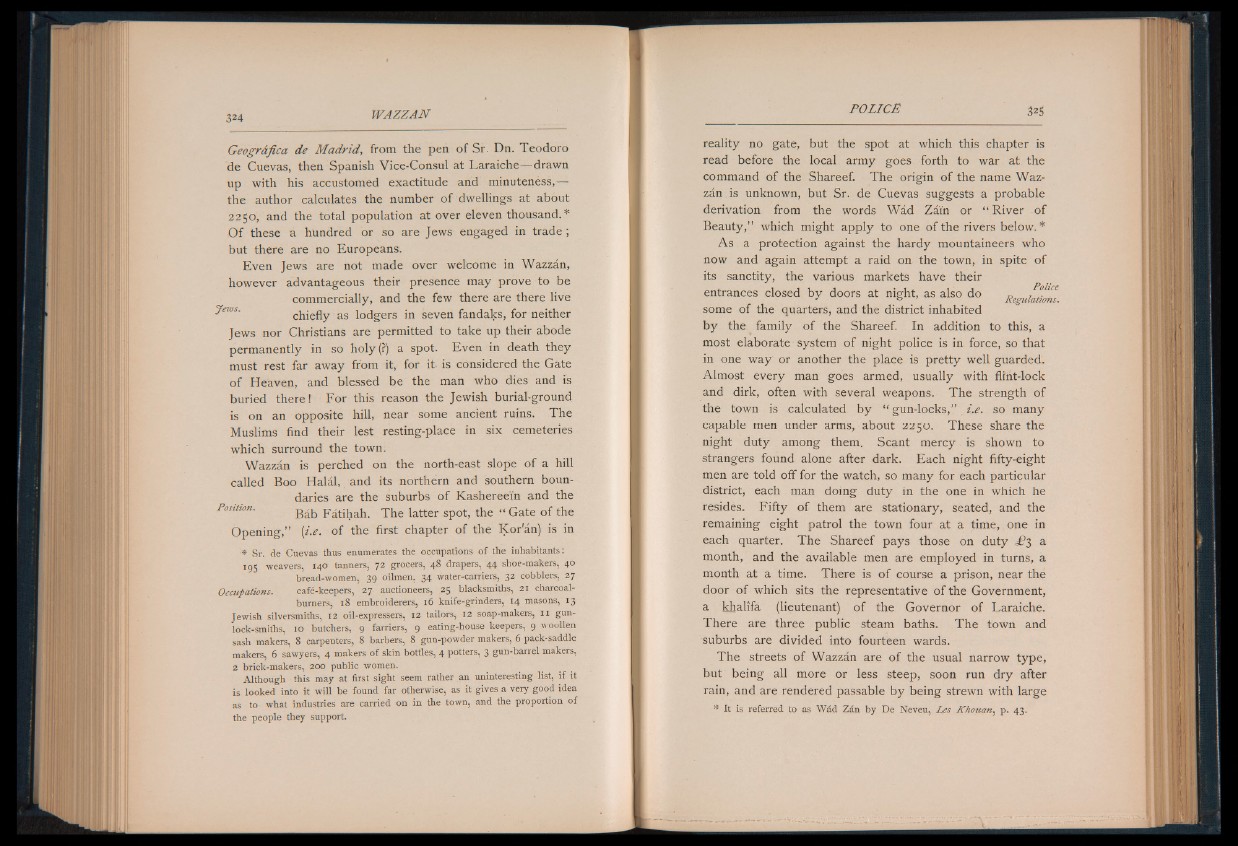
Geografica de Madrid, from the pen of Sr. Dn. Teodoro
de Cuevas, then Spanish Vice-Consul at Laraiche— drawn
up with his accustomed exactitude and minuteness,—
the author calculates the number of dwellings at about
2250, and the total population at over eleven thousand.*
O f these a hundred or so are Jews engaged in trade ;
but there are no Europeans.
Even Jews are not made over welcome in Wazzan,
however advantageous their presence may prove to be
commercially, and the few there are there live
^e7US' chiefly as lodgers in seven fandaks, for neither
Jews nor Christians are permitted to take up their abode
permanently in so holy(?) a spot. Even in death they
must rest far away from it, for it- is considered the Gate
of Heaven, and blessed be the man who dies and is
buried there! For this reason the Jewish burial-ground
is on an opposite hill, near some ancient ruins. The
Muslims find their lest resting-place in six cemeteries
which surround the town.
Wazzan is perched on the north-east slope of a hill
called Boo Halal, and its northern and southern boundaries
are the suburbs of Kashereei'n and the
Position. B ^ b F ^ti]?ah The latter spot) th e « Gate of the
Opening,” (i.e. of the first chapter of the Kor'an) is in
* Sr. de Cuevas thus enumerates the occupations of the inhabitants:
195 weavers, 14a tanners, 72 grocers, 48 drapers, 44 shoe-makers, 40
bread-women, 39 oilmen, 34 water-carriers, 32 cobblers, 27
Occupations. cafe-keepers, 27 auctioneers, 25 blacksmiths, 21 charcoalburners,
18 embroiderers, 16 knife-grinders, 14 masons, 13
Jewish silversmiths, 12 oil-expressers, 12 tailors, 12 soap-makers, 11 gun-
lock-smiths, 10 butchers, 9 farriers, 9 eating-house keepers, 9 woollen
sash makers, 8 carpenters, 8 barbers, 8 gun-powder makers, 6 pack-saddle
makers, 6 sawyers, 4 makers of skin bottles, 4 potters, 3 gun-barrel makers,
2 brick-makers, 200 public women.
Although this may at first sight seem rather an uninteresting list, if it
is looked into it will be found far otherwise, as it gives a very good idea
as to what industries are carried on in the town, and the proportion of
the people they support.
PO LICE
reality no gate, but the spot at which this chapter is
read before the local army goes forth to war at the
command of the Shareef. The origin of the name Wazzan
is unknown, but Sr. de Cuevas suggests a probable
derivation from the words Wad Zain or “ River of
Beauty,” which might apply to one of the rivers below.*
As a protection against the hardy mountaineers who
now and again attempt a raid on the town, in spite of
its sanctity, the various markets have their
entrances closed by doors at night,J & 7 as also do RDe gulBathionHs.
some of the quarters, and the district inhabited
by the family o f the Shareef. In addition to this, a
most elaborate system of night police is in force, so that
in one way or another the place is pretty well guarded.
Almost every man goes armed, usually with flint-lock
and dirk, often with several weapons. The strength of
the town is calculated by “ gun-locks,” i.e. so many
capable men under arms, about 2250. These share the
night duty among them. Scant mercy is shown to
strangers found alone after dark. Each night fifty-eight
men are told off for the watch, so many for each particular
district, each man doing duty in the one in which he
resides. Fifty of them are stationary, seated, and the
remaining eight patrol the town four at a time, one in
each quarter. The Shareef pays those on duty <£*3 a
month, and the available men are employed in turns, a
month at a time. There is of course a prison, near the
door of which sits the representative of the Government,
a khalifa (lieutenant) of the Governor of Laraiche.
There are three public steam baths. The town and
suburbs are divided into fourteen wards.
The streets of Wazzan are of the usual narrow type,
but being all more or less steep, soon run dry after
rain, and are rendered passable by being strewn with large
* It is referred to as Wdd Z£n by De Neveu, Les Khouan, p. 43.